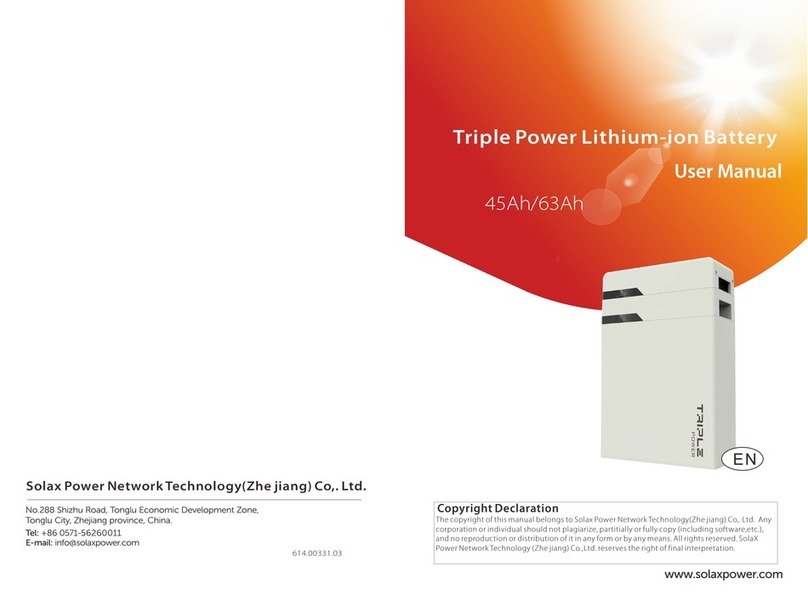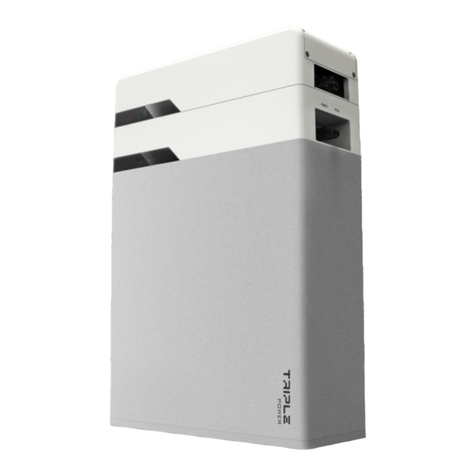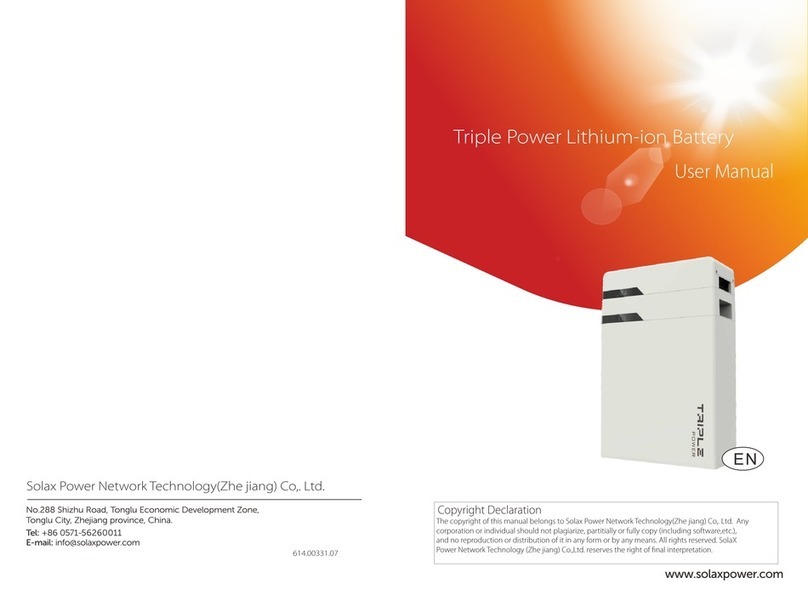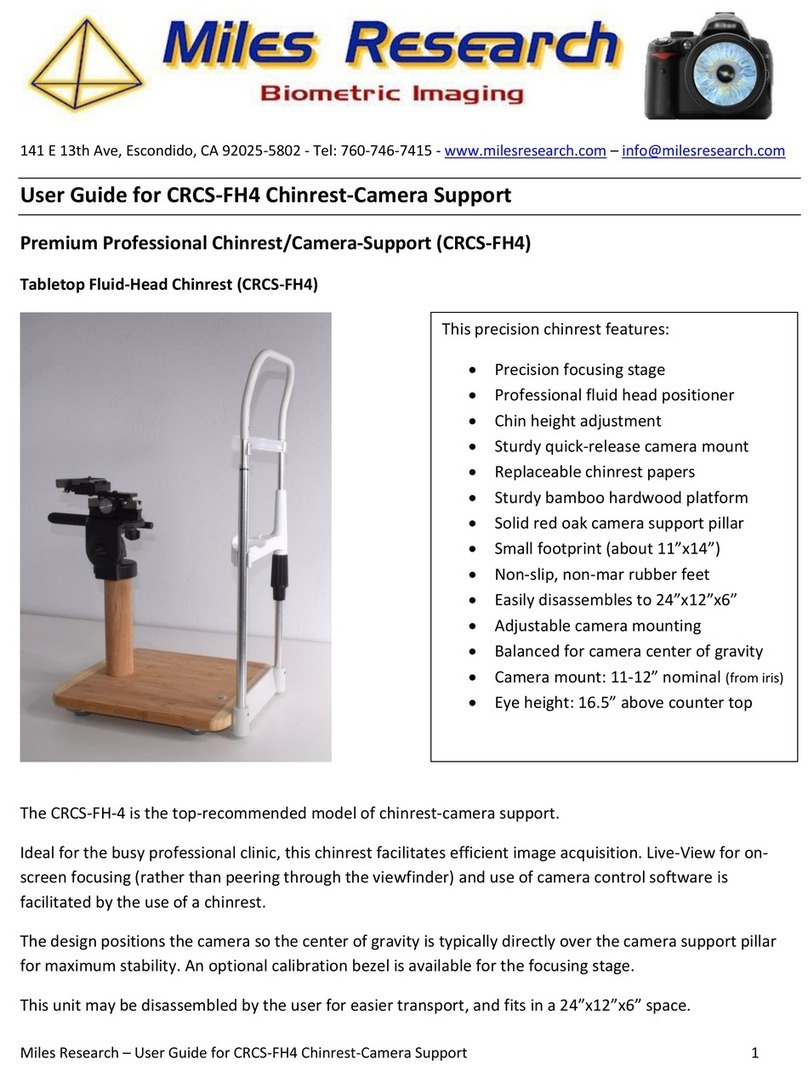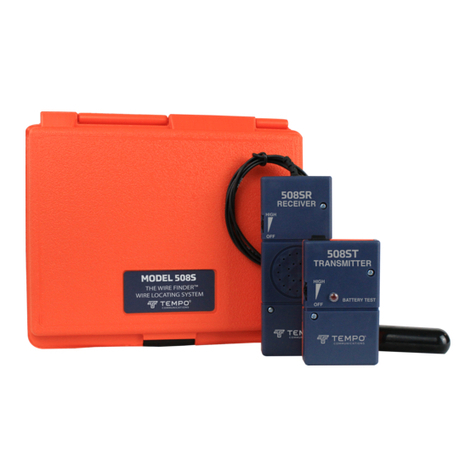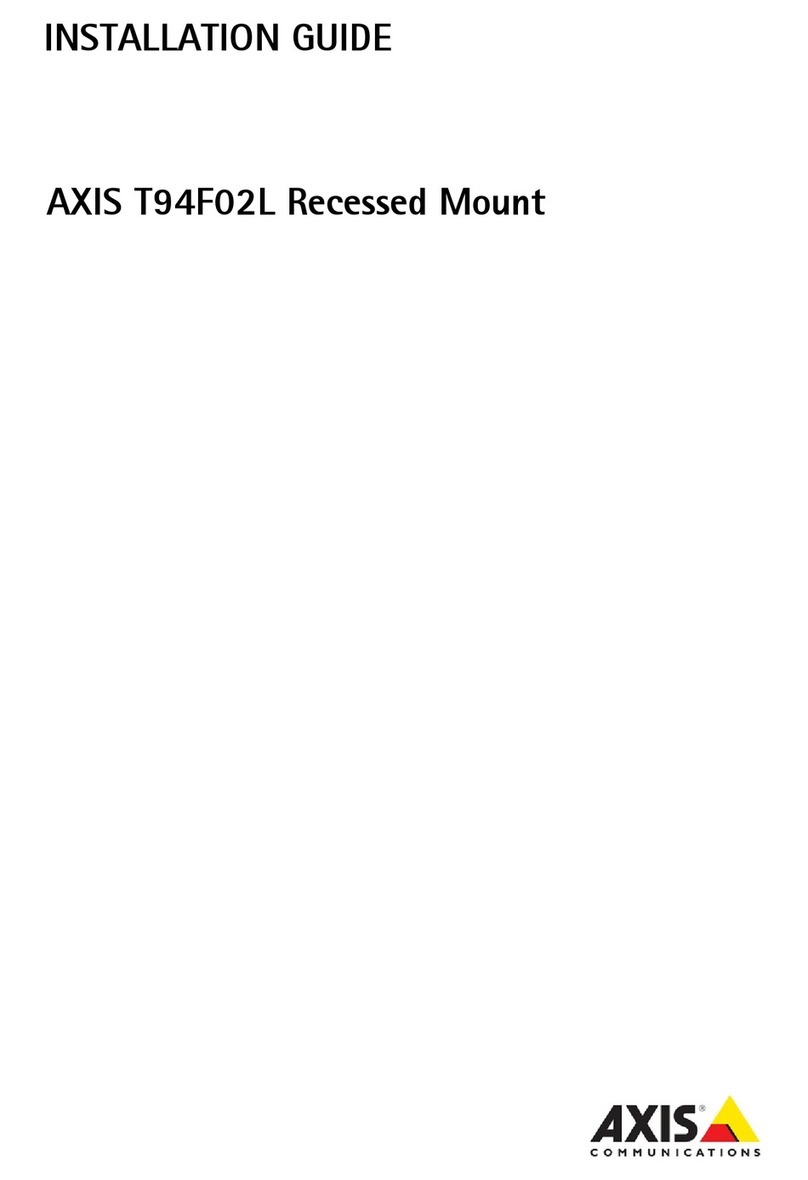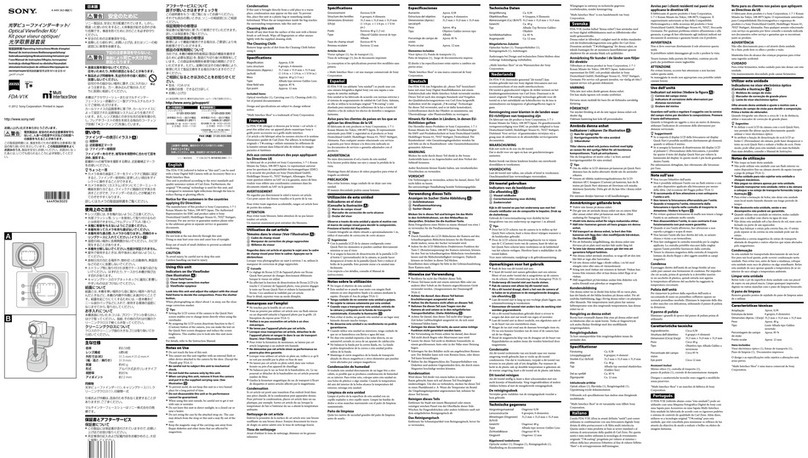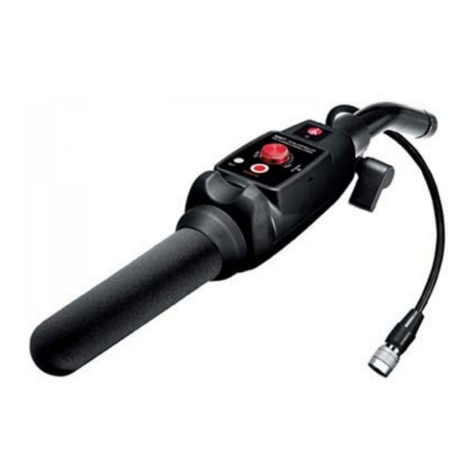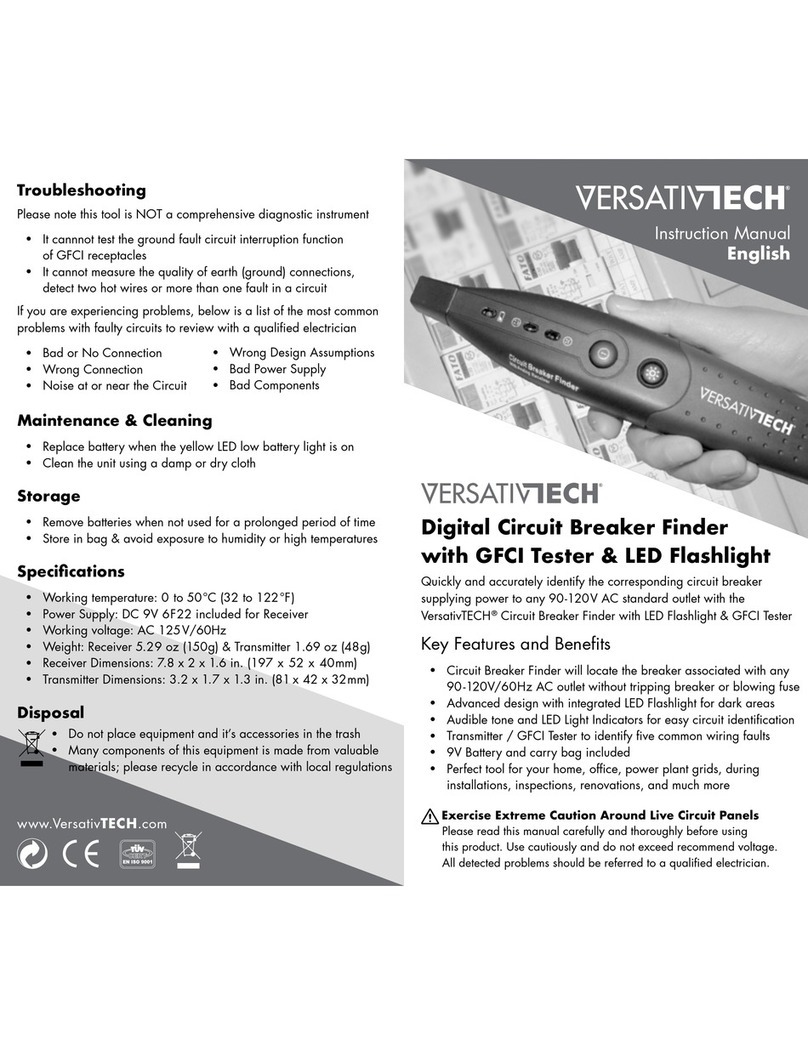SolaX Power Triple Power T-BAT PACK-HV User manual

614.00425.01
Triple Power Lithium-ion Battery
User Manual
50Ah
Copyright Declaration
The copyright of this manual belongs to Solax Power Network Technology(Zhe jiang) Co,. Ltd.
(SolaX Power Co.,Ltd.). Any corporation or individual should not plagiarize, partitially or fully copy
(including software,etc.), and no reproduction or distribution of it in any form or by any means. All
rights reserved. SolaX Power Network Technology (Zhe jiang) Co.,Ltd. (SolaX Power Co.,Ltd.).
reserves the right of final interpretation.
Solax Power Network Technology(Zhe jiang) Co,. Ltd.

CONTENTS
1 NOTE ON THIS MANUAL.......................................................................1
1.1 SCOPE OF VALIDITY..........................................................................................1
1.2 TARGET GROUP...................................................................................................1
1.3 SYMBOLS USED...................................................................................................1
2 SAFETY...................................................................................................2
2.1 SAFET Y INSTRUCTIONS..................................................................................2
2.1.1 GENERAL SAFET Y PRECAUTIONS...............................................................2
2.1.2 EXPLANATION OF SYMBOLS.........................................................................3
2.2 RESPONSE TO EMERGENCY SITUATIONS.................................................5
2.2.1 LEAKING BATTERIES..........................................................................................5
2.2.2 FIRE...........................................................................................................................5
2.2.3 WET BATTERIES AND DAMAGED BATTERIES..........................................5
2.3 QUALIFIED INSTALLER.....................................................................................6
3 PRODUCT INTRODUCTION..................................................................7
3.1 PRODUCT OVERVIEW.......................................................................................7
3.1.1 DIMENSION AND WEIGHT..............................................................................7
3.1.2 APPEARANCE.......................................................................................................8
3.2 BASIC FEATURES.................................................................................................10
3.2.1 FEATURES..............................................................................................................10
3.2.2 CERTIFICATIONS................................................................................................10
3.3 SPECIFICATIONS................................................................................................11
3.3.1 T-BAT SYS-HV CONFIGURATION LIST........................................................11
3.3.2 PERFORMANCE..................................................................................................11
4 INSTALLATION......................................................................................12
4.1 INSTALLATION PREREQUISITES...................................................................12
4.2 SAFET Y GEAR......................................................................................................12
4.3 TOOLS...................................................................................................................13
4.4 INSTALLATION...................................................................................................13
4.4.1 CHECK FOR TRANSPORT DAMAGE...........................................................13
4.4.2 UNPACKING........................................................................................................13
4.4.3 ACCESSORIES.....................................................................................................14
4.4.4 BATTERY INSTALLATION STEPS..................................................................16

1 Note on this Manual
1.1 Scope of Validity
This manual is an integral part of T-BAT Series. It describes the assembly,
installation, commissioning, maintenance and failure of the product. Please read
it carefully before operating.
T-BAT SYS-HV
1.2 Target Group
This manual is for qualified electricians. The tasks described in this manual may
only be performed by qualified electricians.
1.3 Symbols Used
The following types of safety instructions and general information appear in this
document described as below:
DANGER!
“DANGER” indicates a hazardous situation which, if not avoided,
will result in death or serious injury.
WARNING!
“WARNING” indicates a hazardous situation which, if not avoided,
could result in death or serious injury.
CAUTIOIN!
“CAUTION” indicates a hazardous situation which, if not avoided,
could result in minor or moderate injury.
NOTE!
“NOTE” provides tips that are valuable for the optimal operation of
your product.
4.5 CABLE CONNECTION.......................................................................................18
4.5.1 CONNECTING POWER CABLES....................................................................18
4.5.2 CONNECTING POWER LINES........................................................................20
4.5.3 CONNECTING CAN COMMUNICATION CABLE.....................................24
4.5.4 CONNECTING RS485 COMMUNICATION CABLE.................................25
4.5.5 CONNECTING GROUND WIRE......................................................................26
4.5.6 OVERALL INSTALLATION.................................................................................27
4.6 OVERVIEW OF INSTALLATION.......................................................................29
5 COMMISSIONING.................................................................................30
5.1 CONFIGURING BATTERY SYSTEM...............................................................30
5.2 COMMISSIONING..............................................................................................31
5.3 STATUS INDICATORS........................................................................................33
5.3.1 BMS .........................................................................................................................33
5.3.2 BATTERY PACK....................................................................................................34
5.3 SHUTTING DOWN T-BAT SYSTEM...............................................................34
6 TROUBLESHOOTING............................................................................35
6.1 TROUBLE SHOOTING.......................................................................................35
7 DECOMMISSIONING............................................................................38
7.1 DISMANTLING THE BAT TERY.........................................................................38
7.2 PACKAGING..........................................................................................................38
T-BAT H 5.8
NOTE: There are 4 models for T-BAT system, which includes BMS and battery
pack(s). Please refer to section 3.3.1 T-BAT SYS-HV Configuration List on page 11
for detailed models.
T-BAT PACK-HV
HV11550

23
2 Safety
2.1 Safety Instructions
For safety reasons, installers are responsible for familiarizing themselves with the
contents of this manual and all warnings before performing installation.
2.1.1 General Safety Precautions
Observe the following precautions:
ŸRisks of explosion
– Do not subject the battery pack to strong impacts.
– Do not crush or puncture the battery pack.
– Do not dispose of the battery pack in a fire.
ŸRisks of fire
– Do not expose the battery pack to temperatures in excess of 55°C.
– Do not place the battery pack near a heat source, such as a fireplace.
– Do not expose the battery pack to direct sunlight.
– Do not allow the battery connectors to touch conductive objects such as
wires.
ŸRisks of electric shock
– Do not disassemble the battery pack.
– Do not touch the battery pack with wet hands.
– Do not expose the battery pack to moisture or liquids.
– Keep the battery pack away from children and animals.
ŸRisks of damage to the battery pack
– Do not allow the battery pack to get in contact with liquids.
– Do not subject the battery pack to high pressures.
– Do not place any objects on top of the battery pack.
T-BAT SYS-HV can be used only in the household energy field. It is not allowed to
be used in other industries, such as the medical equipment and automotive
application.
WARNING!
Please don't crush or impact the battery, and always dispose it
according to the safety regulation.
2.1.2 Explanation of Symbols
This section gives an explanation of all the symbols shown on the T-BAT system
and on the warning label.
CAUTION!
If the battery is not installed within one month after receiving the battery, the
battery must be charged till the SOC is more than 50% for maintenance.
Lithium ion Rechargeable Battery System
Product Name: T-BAT SYS-HV
Max.Charge/Discharge Current: 35A
Ingress Protection: IP 55
Operating Temperature: 0~+55℃
Storage Temperature: -20~+55℃
SolaX Power Network Technology (Zhejiang) Co., Ltd
ADD: No.288 Shizhu Road, Tonglu Economic Development Zone,
Dongxing District, Tonglu City, Zhejiang Province, China.
TEL: +86 571 5626 0011 E-mail: [email protected]
www.solaxpower.com
Made in China
612.01579.00
Rated Capacity: 50Ah
Model No./Nominal Voltage/Rated Capacity
T-BAT H 5.8/115.2Vdc/5.8kWh IFpP/39/148/95/M/-20+55/90
T-BAT H 11.5/230.4Vdc/11.5kWh IFpP/39/148/95/M/-20+55/90
T-BAT H 17.3/345.6Vdc/17.3kWh IFpP/39/148/95/M/-20+55/90
T-BAT H 23.0/460.8Vdc/23.0kWh IFpP/39/148/95/M/-20+55/90
SN:

45
Wear protecitve glasses
Observe enclosed documentation.
Keep the battery system away from open flames or ignition
sources.
Keep the battery system away from children.
Danger of high voltages.
Danger to life due to high voltages in the battery system!
Danger.
Risk of electric shock!
The battery pack may explode.
Symbol
Explanation
TUV mark for IEC62619
The battery system should be disposed of at a proper facility
for environmentally safe recycling.
The battery system should not be disposed together with the
household waste.
Disposal information can be found in the enclosed documentation.
2.2 Response to Emergency Situations
2.2.1 Leaking Batteries
If the battery leaks electrolyte which is corrosive, avoid contact with the leaking
liquid or gas. Direct contact may lead to skin irritation or chemical burns. If one is
exposed to the leaked substance, do these actions:
Accidental inhalation of harmful substances: Evacuate people from the
contaminated area , and seek medical attention immediately.
Eye contact: Rinse eyes with flowing water for 15 minutes, and seek medical
attention immediately.
Dermal contact: Wash the affected area thoroughly with soap and water, and
seek medical attention immediately.
Ingestion: Induce vomiting, and seek medical attention immediately.
2.2.2 Fire
In case of a fire, make sure an ABC or carbon dioxide extinguisher is nearby.
WARNING!
The battery pack may catch fire when heated above 150°C.
If a fire breaks out where the battery pack is installed, do
these actions:
1. Extinguish the fire before the battery pack catches fire;
2. If the battery pack has caught fire, do not try to
extinguish the fire. Evacuate people immediately.
WARNING!
If the battery pack catches fire, it will produce noxious and poisonous gases.
Do not approach.
2.2.3 Wet Batteries and Damaged Batteries
If the battery pack is wet or submerged in water, do not try to access it.
If the battery pack seems to be damaged, they are not fit for use and may pose a
danger to people or property.
Please pack the battery in its original container, and then return it to SolaX or
your distributor.
CAUTION!
Damaged batteries may leak electrolyte or produce flammable gas. If you
suspect such damage, immediately contact SolaX for advice and information.

2.3 Qualified Installer
WARNING!
All operations of T-BAT SYS-HV relating to electrical connection and
installation must be carried out by qualified personnel.
A skilled worker is defined as a trained and qualified electrician or installer who
has all of the following skills and experience:
ŸKnowledge of the functional principles and operation of on-grid systems
ŸKnowledge of the dangers and risks associated with installing and using
electrical devices and acceptable mitigation methods
ŸKnowledge of the installation of electrical devices
ŸKnowledge of and adherence to this manual and all safety precautions and
best practices
67
3 Product Introduction
3.1 Product Overview
For safety reasons, installers are responsible for familiarizing themselves with the
contents of this manual and all warnings before performing installation.
3.1.1 Demension and Weight
A battery management system (BMS) is any electronic system that manages a
rechargeable battery.
Battery pack is a type of electrical battery which can be charged, discharged into
a load.
A battery system includes BMS and battery pack(s).
HV11550
(Battery Pack)
T-BAT H 5.8
Length
Width
Height
Weight
T-BAT H 5.8 HV11550
474mm
193mm
708mm
72.2kg
474mm
193mm
647mm
68.5kg
3. Product Introduction
708
474
193
647
193
474

ŸSection view of HV11550
3. Product Introduction 3. Product Introduction
89
3.1.2 Appearance
ŸSection view of T-BAT H 5.8
Object Mark Description
Ⅰ
Ⅱ
Ⅲ
Ⅳ
BAT+/BAT-
CAN
GND
/
Charge/Discharge Connectors
CAN Connector
GND
Air Valve
Object Mark Description
Ⅰ’
Ⅱ’
Ⅲ’
Ⅳ’
Ⅴ’
XPLUG
+
RS485 I
GND
/
Ⅰ
Ⅱ Ⅲ
Ⅳ
Ⅴ Ⅵ
Ⅶ
ⅧPower Connector’ to YPLUG of upper battery pack
RS485 Connector to RS485 II of upper battery pack
GND
RS485 Connector to RS485 I of next battery pack
Power Connector’ to XPLUG of next battery pack, or
to “-” of the same pack
Air valve
Ⅸ
BAT+BAT-
CAN
-YPLUG
RS485 II
Ⅹ
Ⅲ
+
XPLUG
RS485 I
-YPLUG
RS485 II
Ⅰ’Ⅱ’
Ⅲ’Ⅳ’
Ⅴ’
Ⅵ’Ⅶ’
Ⅷ’Ⅳ’
Power Connector to “-” of upper battery pack
Power Connector to + of next battery pack, or to YPLUG
of the same pack
RS485 Connector to RS485 I of next battery pack
Power Button
DIP Switch
Circuit Breaker
Ⅴ
Ⅵ
Ⅶ
Ⅷ
Ⅸ
Ⅹ
-
YPLUG
RS485 II
POWER
DIP
ON/OFF
Power Connector’ to XPLUG of next battery pack,
or to “-” of the same pack
Power Connector to + of next battery pack, or to
YPLUG of the same pack
Ⅵ’
Ⅶ’
Ⅷ’
-
YPLUG
RS485 II

3.2 Basic Features
3.2.1 Features
The T-BAT SYS-HV is one of the advanced energy storage systems on the market
today, incorporating state-of-the-art technology, high reliability, and convenient
control features shown as below:
Ÿ90% DOD
Ÿ99% Faradic charge efficiency
Ÿ95% Battery roundtrip efficiency
ŸCycle life > 6000 times
ŸSecondary Protection by hardware
ŸIP55 protection level
ŸSafety & Reliability
ŸSmall footprint
ŸFloor or wall mounting
3.2.2 Certifications
3. Product Introduction 3. Product Introduction
10 11
T-BAT system safety
Battery cell safety
UN number
Hazardous materials classication
UN transportation testing requirements
International protection marking
CE, FCC, RCM, TUV (IEC 62619)
UL 1642
UN 3480
Class 9
UN 38.3
IP 55
3.3 Specifications
3.3.1 T-BAT SYS-HV Configuration List
3.3.2 Performance
Model Battery Pack Energy(kWh) Voltage (V)No.
1
2
3
4
T-BAT H 5.8
T-BAT H 11.5
T-BAT H 17.3
T-BAT H 23.0
T-BAT H 5.8*1
T-BAT H 5.8*1+HV11550*1
T-BAT H 5.8*1+HV11550*2
T-BAT H 5.8*1+HV11550*3
5.8
11.5
17.3
23.0
100-131
200-262
300-393
400-524
T-BAT H 5.8 HV11550
Dimension(mm)
Weight(kg)
Nominal Voltage(Vdc)
Operating Voltage(Vdc):
Nominal Capacity(Ah):
Max. charge/discharge Current(A) :
Recommend Charge/Discharge Current (A):
Standard Power(kW)
Maximum Power(kW)
474* 193*708
72.2
115.2
100-131
50
35
25
2.5
3.5
474*193*647
68.5
115.2
100-131
50
35
25
2.5
3.5
Altitude(m)
Faradic Charge Efficiency(25℃/77℉)
Battery Roundtrip Efficiency(C/3,25℃/77℉)
Expected Lifetime(25℃/77℉)
Cycle life(90% DOD,25℃/77℉)
Available Operating Temperature
Optimal Operating Temperature
Storage Temperature
Ingress Protection
≤2000
99%
95%
5 years
6000 cycles
0--55℃
15℃--35℃
-20℃--55℃ (3 months)
0℃--40℃ (1 year)
IP55

4 Installation
4.1 Installation Prerequisites
Make sure that the installation location meets the following conditions:
ŸThe building is designed to withstand earthquakes
ŸThe location is far away from the sea, to avoid salt water and humidity
ŸThe floor is flat and level
ŸThere are no flammable or explosive materials nearby
ŸThe ambience is shady and cool, keep away from heat and avoid direct
sunlight.
ŸThe temperature and humidity stays at a constant level.
ŸThere is minimal dust and dirt in the area.
ŸThere is no corrosive gases present, including ammonia and acid vapor.
ŸThe ambient temperature is within the range from 0°C to 55°C, and the
optimal ambient temperature is between 15℃ and 35°C.
NOTE!
If the ambient temperature is outside the operating range, the battery pack
stops operating to protect itself. The optimal temperature range for the battery
pack to operate is 15°C to 35°C. Frequent exposure to harsh temperatures may
deteriorate the performance and lifetime of the battery pack.
4.2 Safety Gear
Installation and maintenance personnel must operate according to applicable
federal, state and local regulations as well as the industry standards regarding the
product installation personnel shall wear safety gears, etc. in order to avoid short
circuit and personal injury.
Insulated gloves Safety goggles Safety shoes
4. Installation
12 13
4. Installation
4.3 Tools
These tools are required to install the T-BAT system.
Torque screw driver Phillips-screw driver Socket nut wrench
Phillips-head screw driver Flat-head screw driver Torque wrench
Tape measure Drill Pencil or Marker
4.4 Installation
4.4.1 Check for Transport Damage
Make sure the battery is intact during transportation. If there are some visible
damages, such as cracks, please contact your dealer immediately.
4.4.2 Unpacking
Unpacking the battery package by cutting the packing tape and make sure the
battery packs and the relevant items are complete. See package items on section
4.4.3, please check the packing list carefully, if there's any item missing, please
contact SolaX or your distributer directly.
CAUTION!
According to regional regulations, several people may be required for
moving equipment.
WARNING!
Please strictly follow the installation steps. SolaX will not answer for any
hurting or loss arising by incorrectly assembling and operation.
NOTE!
The Triple Power battery pack is rated at IP55 and thus can be installed
outdoors as well as indoors. However, if installed outdoors, do not allow the
battery pack to be exposed to direct sunlight and moisture.

4. Installation 4. Installation
15
14
4.4.3 Accessories
E
HJ
The table below lists the number of each component.
T-BAT H 5.8:
K
Object
A
B
C
D
E
F
G
H
I
J
K
L
Description
Power line between Inverter and T-BAT H 5.8 (+) (2m)
Power line between Inverter and T-BAT H 5.8 (-) (2m)
CAN communication cable (2m)
Series-connected plug
Cover plate1
M4 screw
Cover plate2
Wall bracket
M5 screw
Expansion bolt
Ring terminal (for grounding)
Power cable disassembling tool
Quantity
1
1
1
1
2
8
2
1
1
5
2
1
L
HV11550:
Quantity Object
A1
B1
C1
D1
E1
F1
G1
H1
I1
J1
Description
Power cable between battery packs (650mm)
Power cable’ between battery packs (650mm)
RS485 communication cable (650mm)
Cover plate1
M4 screw
Cover plate2
Wall bracket
M5 screw
Expansion bolt
Ring terminal (for grounding)
AB C
D
A1
F
I
B1 C1
G1 H1F1
I1
D1 E1
1
1
1
2
8
2
1
1
5
2
The table below lists the number of each component.
G
J1

4. Installation 4. Installation
16 17
4.4.4 Battery Installation Steps
It is recommended that the space between battery packs is more than
300mm.
Steps (for T-BAT H 5.8 or HV11550):
Make sure the wall is strong enough to withstand the weight of battery packs.
Step 1: fix the wall bracket (H or G1) on the wall
ŸUse the wall bracket as a template to mark the position of the 5 holes
ŸDrill holes with φ10drill, make sure the holes are deep enough (at least
50mm) for installing and tightening the expansion bolts (J or I1)
ŸInstall the expansion bolts in the wall, and screw the bracket by using the
wrench.
Step 2: Match the battery with the wall bracket
ŸTransport the battery to the wall bracket
ŸHang the battery over the wall bracket, move the battery close to it, and
match it on the wall bracket
Step3: Lock the joint between hanging board and wall bracket with M5
combinationscrew (I or H1).
380<height<650mm
Note: Keep the distance from installation point to the floor less than 650mm.
30<height<300(mm)
Side view of hanging the battery to
the wall bracket.

4.5 Cable Connection
4. Installation 4. Installation
18 19
1. The only step of connecting power cable for T-BAT H 5.8 is connecting the
series-connected plug to “-” and “YPLUG” on the right side. The series-connected
plug is used to make a complete circuit.
-YPLUG
RS485 II
-YPLUG
RS485 II
-YPLUG
RS485 II
For T-BAT H 5.8 + 1~3 battery packs:
1. Connect “-” (Ⅴfor T-BAT H 5.8 or Ⅵ’ for HV11550) on the right side to “+” (Ⅱ’) on
the left side of the next battery pack.
2. Connect “YPLUG” (Ⅵ for T-BAT H 5.8 or Ⅶ’ for HV11550) on the right side to
“XPLUG” (Ⅰ’) on the left side of the next battery pack.
3. The rest battery packs are connected in the same way.
4. Insert the series-connected plug at “-” and “YPLUG” on the right side of last
battery pack to make a complete circuit.
-YPLUG
RS485 II
-YPLUG
RS485 II
4.5.1 Connecting Power Cables
For T-BAT H 5.8:
XPLUG +
RS485
-YPLUG
RS485 II

2. Keep the Inverter off. Connect the other end of power lines (+,-) to the correct
port on the Inverter.
+
-
WiFi
RF
485
BMS
Upgrade
AC
BAT DRM
Meter
NOTE!
1. When connecting the cable to Inverter, fit the two connectors together until
the connection audibly locks into place.
2. Check to make sure the connection is securely locked.
3. Don't shake both ends of the cable at the joint once the connection is locked.
4.5.2 Connecting Power Lines
1. Connect the the positive cable (+) (A) and negative cable (-) (B) to the
corresponding port as shown in the following figure.
-
+
BAT- BAT+
CAN
BAT- BAT+
CAN
4. Installation 4. Installation
20 21
Connecting Charging Cables between Inverter and T-BAT System:
Ø
This step is going to connect power lines between Inverter and T-BAT system.
The default length of power lines are 2 meters, so customers can appropriately
cut the cable accroding to the actual installation environment. As a result, each
power line has one terminal block when leaving the factory, and customers need
to connect the other end of terminal block by themselves.
Cable Connection Steps:
Ø
Step2. Insert the stripped cable up to the stop (negative cable for DC plug(-) and
positive cable for DC socket(+) are live). Hold the housing on the screw
connection.
Step3. Press down spring until it clicks audibly into place (it must be possible to
see the fine wire strands in the chamber)
Step1. Strip the cable to 15mm.
DC plug housing(-) DC socket housing(+)
screw connection
screw connection
spring
chamber
wire strands
Step4. Tighten the screw connection(tighten torque:2.0±0.2Nm)
Step2.
Step3.Step 4.

-
+
BAT- BAT+
CAN
Disassemble the power line by plugging the slot type screwdriver to the terminal
groove of charging cable. Please see the illustration as shown below:
BAT- BAT+
CAN
BAT- BAT+
CAN
DO NOT disassemble power cables when the T-BAT system is not
turned off, otherwise there will be an arc discharge that could cause
serious injury!
CAUTION!
Disassembling Power Line (on BAT+, BAT-, “+”, XPLUG port)
Ø
22 23
4. Installation 4. Installation
-YPLUG
RS485 II
Disassemble the power line by plugging the Power cable disassembling tool(L)
to the terminal groove of charging cable. Please see the illustration as shown
below:
-YPLUG
RS485 II
-YPLUG
RS485 II
Disassembling Power Cable (on ”-”, YPLUG port)
Ø

24 25
4. Installation 4. Installation
4.5.3 Connecting CAN Communication Cable
It is required for the BMS to communicate with the inverter for proper operation.
2. Connect the CAN communication cable to
the CAN connector (Ⅱ) which is marked in red.
Insert the other end of the CAN communication
cable to the CAN connector. Assemble the cable
gland and screw the cable nut.
1. Insert one end of the CAN communication
cable (C) which has no cable nut directly to the
BMS port of the Inverter.
BAT- BAT+
CAN
The wire order of the communication cable is as follows:
1 2 3456 7 8
1) White with an orange stripe
2) Orange
3) White with a green stripe
4) Blue
5) White with a blue stripe
6) Green
7) White with a brown stripe
8) Brown
Sequence 1 2 3 4 5 6 7 8
CAN /GND /CAN_H CAN_L /A1 B1
4.5.4 Connecting RS485 Communication Cable
For T-BAT H 5.8:
There's no need to use RS485 communicaton cable.
For T-BAT H 5.8 + 1~3 battery packs:
Connect RS485 II (Ⅶfor T-BAT H 5.8 orⅧ’ for HV11550) of upper battery on the
right side to RS485 I (Ⅲ’) of the follow-up battery pack which is on the left.
Assemble the cable gland and screw the cable nut.
Sequence 1 2 3 4 5 67 8
RS485I
RS485II
VCC_485
VCC_485
GND_485
GND_485
B2
B2
N-
N-
P+
P+
A2
A2
VCC_485_2
VCC_485_2
GND_485
GND_485
The wire order of the communication cable is as follows:
-YPLUG
RS485 II
-YPLUG
RS485 II
-YPLUG
RS485 II
+XPLUG
RS485 I

4. Installation 4. Installation
26 27
4.5.5 Connecting Ground Wire
CAUTION!
GND is mandatory!
The terminal point for GND connection is on the side of grooves as shown
below:
-YPLUG
RS485 II
Cable size: 10AWG.
ring terminal
-YPLUG
RS485 II
4.5.6 Overall Installation
It is recommended to protect the cables by using corrugated pipe.
For T-BAT H 5.8:
1. Connect all the cables on the left side of T-BAT H 5.8.
2. Get the cables through the corrugated pipe.
3. DO remember to insert the series-connected plug at “-” and “YPLUG” on the
right side of T-BAT H 5.8 to make a complete circuit.
4. Set the cables into the groove of metal plates and screw them back to the
battery pack on both sides.

4. Installation 4. Installation
28 29
For T-BAT H 5.8 + 1~3 battery packs:
1. Connect the cables at one end of the T-BAT H 5.8/HV11550.
2. Get the cables through the corrugated pipe.
3. Set the cables into the groove of metal plates and screw them back to the
battery pack on both sides.
4. DO remember to insert the series-connected plug at “-” and “YPLUG” on the
right side of last battery pack to make a complete circuit.
CAUTION!
One T-BAT system is allowed to install one T-BAT H 5.8 plus at most three
battery packs. Connecting more than three battery packs will blow the
fuse, and the battery pack will be damaged. Please make sure the
number of battery packs meets the requirement.
4.6 Overview of Installation
The following diagram is a complete T-BAT system installation with T-BAT H 5.8 +
three battery packs.

30 31
5 Commissioning
5.1 Configuring Battery System
The DIP switch is used to configure the number of battery packs which are
communicating to Inverter. The detailed configuration information is shown as
follows:
0
1
2
3
4
5
6
7
Configuration activated by inverters
0- Matching T-BAT H 5.8 (default)
1- Matching T-BAT H 5.8 + 1*HV11550
2- Matching T-BAT H 5.8 + 2*HV11550
3- Matching T-BAT H 5.8 + 3*HV11550
The black-start function is only used in the off-grid environment and there is no
other power supply.
Note: if the battery is started in black-start mode, although there is no BMS
communication, the port still has high voltage and there is a risk of electric
shock!
After the black-start mode is started, if the BMS communication has still not been
built within 3 minutes , the black start fails.
4- Matching T-BAT H 5.8
5- Matching T-BAT H 5.8 + 1*HV11550
6- Matching T-BAT H 5.8 + 2*HV11550
7- Matching T-BAT H 5.8 + 3*HV11550
Black-start configuration
Ø
5. Commissioning
5. Commissioning
NOTE!
When powering on the BMS, the system will start self-testing. If the
buzzer bips, it means DIP configuration fault or communication failure
occurs. If the buzzer bips, please check if the number of battery packs is
corresponding to the DIP configuration, and also check if the RS485
communication calbes are correctly connected. After these two
situation checked OK, press the POWER button to power on, and press
the POWER button again 10s later. In addition: The buzzer will only
alarm on the corresponding fault during the power-on self-test. After
the self-test is completed, it won't bip again even if the same fault
occurs.
NOTE!
Frequently pressing the POWER button may cause the system error.
Please make sure at least 10 seconds is needed when you are going to
press the POWER button from the last pressing operation.
5.2 Commissioning

Commissioning Steps
If all the battery packs are installed, follow these steps to put it in operation.
1. Remove the upper cover board of T-BAT H 5.8;
2. Remove the small cover plate;
3. Rotate the DIP to corresponding number with small tool accroding to the
number of battery pack(s) that has(have) been installed;
4. Move the circuit breaker to the ON position;
5. Press the POWER button to turn on the T-BAT system;
6. Put the small cover plate back;
7. Reinstall the upper cover board to T-BAT H 5.8;
8. Power on the Inverter.
1
small cover plate
2
3
4
5
5. Commissioning
5. Commissioning
32 33
No.
1
2
3
Mode
Power off
Inverter sends Idle command
BMS Protection
Status of BMS
5.3 Status Indicators
The LED indicators on the front panel of the battery pack are showing the
operating status.
5.3.1 BMS
The capacity indicators show the SOC:
ŸWhen the battery pack is neither charging nor discharging, the indicator
lights off.
ŸWhen the battery pack is charging, part of the Blue LED is flashing with the
frequency of light on for 0.5s, light off for 0.5s, and part of the Blue LED keeps
light on. Take SOC 60% for instance, in charging state:
1. The first two Blue LED indicators keeps on
2. The third Blue LED indicator flashes once every 1s
ŸWhen the battery pack is discharging, the Blue LED is flashing with the
frequency of light on for 1s, and light off for 4s. Take SOC 60% for instance, in
discharging state:
1. The first three blue LED indicators flash once every 5s
The following table shows the status of BMS.
Charging Discharging
25%50%75%100%
SOC Status
The Green LED is light on for 0.3s, and light off for 0.3s
The Green LED keeps light on
25%50%75%100%
SOC Status 25%50%75%100%
SOC Status
Light off
The Green LED is light on for 1s, and light off for 4s
The Orange LED is light on for 1s, and light off for 4s
The Red LED keeps light on for 10min, then
ickers with light on for 1s, and light off for 4s
Upgrade for BMS
Active
Fault
5
6
4

5. Commissioning
34 35
5.3.2 Battery Pack
S2
5.4 Shutting Down T-BAT System
To shut down the system, follow the steps described below:
1. Turn off the breaker between Inverter and battery pack;
2. Open the upper cover board;
3. Power off the BMS;
4. Turn off the system by moving the circuit breaker switch to the OFF position;
5. Make sure that every indicator on the T-BAT system is off;
6. Disconnect the cables.
No.
1
2
3
Mode
Power off/Sleep
Active
Protection
Upgrade for BMS
Status of battery pack
S1
S1 and S2 represent independent status indicators. The status of S1 and S2 have
the same meaning for battery pack in the following table.
Note: only when both S1 and S2 are flashing once every 5s in Green LED, it
means the battery system is active.
NOTE!
After powering off the BMS, the LED lights of S1 and S2 will keep
flashing in 20 minutes.
Light off
The Green LED is light on for 1s, and light off for 4s
The Orange LED is light on for 1s, and light off for 4s
The Green LED is light on for 0.3s, and light off for 0.3s
4
5
The Red LED keeps light on for 10min, then
ickers with light on for 1s, and light off for 4s
Fault
6 Troubleshooting
6.1 Troubleshooting
Check the indicators on the front to determine the state of the T-BAT system. A
warning state is triggered when a condition, such as voltage or temperature is
beyond the design limitations. The T-BAT system's BMS periodically reports its
operating state to the inverter.
When the T-BAT system falls outside prescribed limits, it enters a warning state.
When a warning is reported, the inverter immediately stops operation.
Use the monitoring software on the inverter to identify what caused the warning.
The possible warning messages are as follows:
BMS_External_Err
The communication
between BMS and
Inverter is interrupted
Check if the
communication cable
between BMS and Inverter
is correctly and well
connected.
BMS_Internal_Err
1. DIP switch at the
wrong position;
2. The communication
between battery packs
is interrupted
1. Move the DIP switch to
the correct position;
2. Check if the
communication cable
between battery packs is
correctly and well
connected.
BMS_OverVoltage
Battery over voltage
Please contact SolaX after-
sales service or your
distributor directly.
BMS_LowerVoltage
Battery under voltage
Please contact SolaX after-
sales service or your
distributor directly.
BMS_ChargeOCP
Battery charge over
current protection
Please contact SolaX after-
sales service or your
distributor directly.
BMS_DishargeOCP
Battery discharge over
current protection
Please contact SolaX after-
sales service or your
distributor directly.
Warning Messages Description Troubleshooting
6. Troubleshooting
This manual suits for next models
1
Table of contents
Other SolaX Power Camera Accessories manuals
